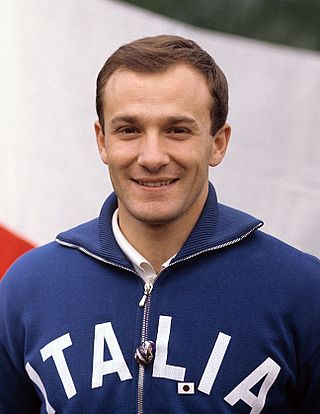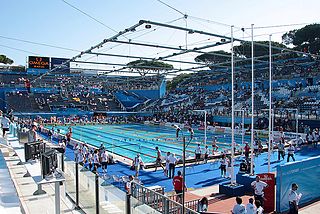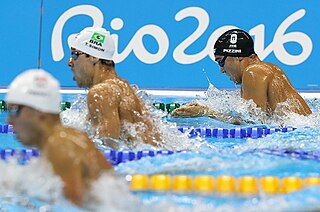
Stadio Olimpico, colloquially known as l'Olimpico, is an Italian multi-purpose sports venue located in Rome. Seating over 70,000 spectators, it is the largest sports facility in Rome and the second-largest in Italy, after Milan's San Siro. It formerly had a capacity of over 100,000 people, and was also called Stadio dei Centomila. It is owned by Sport e Salute, a government agency that manages sports venues, and its operator is the Italian National Olympic Committee.

The Italian Open is an annual professional tennis tournament held in Rome, Italy. It is played on clay courts at the Foro Italico, and is held during the second week of May. The tournament is part of the ATP Masters 1000 events on the ATP Tour and part of the WTA 1000 events on the WTA Tour. The two events were combined in 2011.

Fascist architecture encompasses various stylistic trends in architecture developed by architects of fascist states, primarily in the early 20th century. Fascist architectural styles gained popularity in the late 1920s with the rise of modernism along with the ultranationalism associated with fascist governments in western Europe. Fascist styles often resemble that of ancient Rome, but can extend to modern aesthetics as well. Fascist-era buildings are frequently constructed with particular concern given to symmetry; simplicity; and monumental size, especially for public buildings.

Graziano Mancinelli was an Italian show jumping rider.

The Palazzo della Farnesina is an Italian government building located between Monte Mario and the Tiber River in the Foro Italico area in Rome, Italy. Designed in 1935, it has housed the Italian Ministry of Foreign Affairs since its completion in 1959. A reference to "La Farnesina" is often to be intended as a metonymy for the hosted institution, namely the Ministry itself.

The 2001 Summer Deaflympics, officially known as the 19th Summer Deaflympics, is an international multi-sport event that was celebrated from 16 July to 1 August 2001, in Rome, Italy.

Sante Gaiardoni was an Italian cyclist. He won two gold medals at the 1960 Olympic Games in Rome, in the 1000 m time trial and the 1000 m sprint. Between 1958 and 1970 he won two gold, four silver and two bronze medals in sprint events at the UCI Track Cycling World Championships.

Franco Menichelli is a retired Italian gymnast. He competed in all artistic gymnastics events at the 1960, 1964 and 1968 Olympics and won one gold, one silver, and three bronze medals.

Eraldo Pizzo is an Italian water polo player who competed in the 1960 Summer Olympics, in the 1964 Summer Olympics, in the 1968 Summer Olympics, and in the 1972 Summer Olympics.
Enrico Del Debbio was an Italian architect and university professor.

The Stadio dei Marmi is one of four stadiums in the colossal sports complex the Foro Italico, initially named Foro Mussolini. The other stadiums are the Stadio Olimpico, the Stadio del tennis Romano, and the Stadio Olimpico del Nuoto. It was designed in the 1920s as a complement to the annexed Fascist Academy of Physical Education, to be used by its students for training. The Stadio dei Marmi first opened in 1932, on the 10th anniversary of the March on Rome, near the Roman neighborhood Monte Mario, by the architect Enrico Del Debbio under the Fascist ruler Benito Mussolini. The Stadio dei Marmi is encircled by sixty, 4-meter tall classical statues of athletes made from Carrara marble. The stadium was built to celebrate Fascist accomplishments and the Gioventú del Littorio, the youth movement of the National Fascist Party of Italy. In its twenty-year reign, the Fascist regime used sports to introduce and instill new fascist traditions, ideals, customs, and values, with the goal of forming citizen warriors. The Stadio dei Marmi was used to host some of the field hockey preliminaries for the 1960 Summer Olympics and also hosted the opening ceremony for the 2009 World Aquatics Championships.

The Stadio Olimpico del Nuoto is an aquatics centre at the Foro Italico in Rome, Italy. Inaugurated in 1959, it was designed by the architects Enrico Del Debbio and Annibale Vitellozzi to host the swimming, diving, water polo, and swimming portion of the modern pentathlon events for the 1960 Summer Olympics.

The Academia della Farnesina, also known as the Accademia fascista maschile di educazione fisica or Accademia fascista della Farnesina, was a centre for sport and political education in Fascist Italy.

Rome 2020 was a proposed bid for the 2020 Summer Olympics by the city of Rome and the Italian National Olympic Committee. Rome had previously hosted the 1960 Summer Olympics. The bid for the 2020 Games was withdrawn due to the lack of support from the Italian government.

Lungotevere Maresciallo Cadorna is a stretch of the Lungotevere, a boulevard that runs along the Tiber River in the Della Vittoria quarter of Rome, Italy. It links Piazzale Maresciallo Giardino to Piazza Lauro De Bosis.

Luca Pizzini is an Italian swimmer specialized in breaststroke. A junior medallist at both European and World Championships, he earned bronze medals in the 2013 Summer Universiade and the 2016 European Aquatics Championships. He also competed in the men's 200 metre breaststroke event at the 2016 Summer Olympics.

Walk of Fame of Italian sport is the Walk of Fame of the Italian sport, inaugurated by Italian National Olympic Committee (CONI) on 7 May 2015. It is a list of 140 Italian all-time champions, which has been implemented on six occasions, from the initial 100 names.

1985 World Masters Athletics Championships is the sixth in a series of World Masters Athletics Outdoor Championships that took place in Rome, Italy, from June 22 to 30, 1985.

Studio fotografico Vasari it is one of the oldest Italian companies operating in the field of photography.
Stadio Olimpico is a stadium in Rome, Italy
























